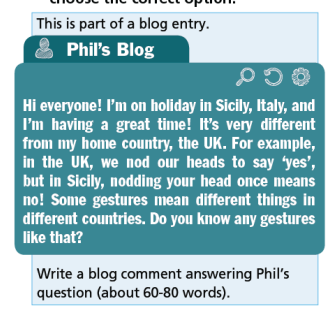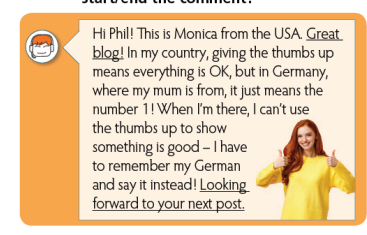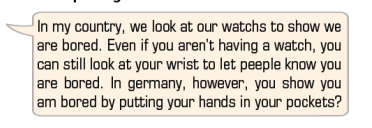5. Fill in each gap with shake, thumbs up, wish or curl.
(Điền vào chỗ trống các từ: shake, thumbs up, wish hoặc curl.)
1. In Asia, it’s rude to _____ your index finger to ask somebody to come to you.
2. In Australia, the _____ means everything is OK.
3. It’s polite to _____ hands when you greet someone.
4. Don’t cross your fingers to _____ for luck in Vietnam. It’s very rude!
1. In Asia, it’s rude to curl your index finger to ask somebody to come to you.
(Ở châu Á, thật thô lỗ khi cong ngón trỏ khi gọi ai đó đến gần bạn.)
2. In Australia, the thumbs up means everything is OK.
(Ở Úc, giơ ngón tay cái lên có nghĩa là mọi thứ đều ổn.)
3. It’s polite to shake hands when you greet someone.
(Bắt tay khi bạn chào ai đó là phép lịch sự.)
4. Don’t cross your fingers to wish for luck in Vietnam. It’s very rude!
(Đừng đan chéo ngón tay để chúc may mắn ở Việt Nam. Điều đó rất thô lỗ!)

Các bài tập cùng chuyên đề
3. What makes a good friend? Put the ideas in the list under the headings. Add two more of your own.
(Điều làm nên người bạn tốt? Đặt các ý tưởng trong danh sách dưới tiêu đề. Thêm hai cái nữa của riêng bạn.)

Writing (Phần viết)
9. Write a blog post about your favourite free-time activities and hobbies (about 60-80 words).
(Viết một bài đăng trên blog về các hoạt động và sở thích khi rảnh rỗi yêu thích của bạn (khoảng 60-80 từ).)
Câu 1: Read the task. Underline the key words. For the statements (1- 3), choose the correct option.
(Đọc bài. Gạch chân dưới từ khóa. Với mệnh đề (1- 4), chọn đáp án đúng.)
This is part of blog entry
(Đây là một phần của Blog)
Phil’s Blog
Hi everyone! I’m on holiday in Sicily, Italy, and I’m having a great time! It’s very different from my home country, the UK. For example, in the UK, we nod our heads to say “yes”, bit in Sicily, nodding your head means no! Some gestures mean different things in different countries. Do you know any gestures like that?
Write a blog comment answering Phil’s question (about 60- 80 words)
(Viết một bình luận để trả lời câu hỏi của Phil (khoảng 60- 80 từ))
1. You are going to write a comment/letter on a blog entry.
2. You are going to write about a holiday/gesture.
3. You are going to write about 60- 80/80- 100 words.
Model analysis (Phân tích mẫu)
2. Read the model. How does the writer start/end the comment?
(Đọc đoạn văn mẫu. Người viết bắt đầu/kết thúc bình luận như thế nào?)
Hi Phil! This is Monica from the USA. Great blog! In my country, giving the thumbs up means everything is OK, but in Germany, where my mum is from, it just means the number 1! When I’m there, I can’t use the thumbs up to show something is good- I have to remember my German and say it instead! Looking forward to your next post.

3. Replace the underlined sentences with the sentences below in your notebook.
(Thay thế các câu được gạch chân với các câu dưới đây vào vở của bạn.)
1. Can’t wait for your next blog entry.
(Không thể chờ đến bài đăng tiếp theo của bạn!)
2. I really enjoy reading your posts.
(Tôi thực sự rất thích đọc bài đăng của bạn.)
4. Read the extract from a blog entry and correct two grammar mistakes, two punctuation mistakes and two spelling mistakes.
(Đọc đoạn trích từ blog và sửa 2 lỗi sai về ngữ pháp, 2 lỗi sai của dấu câu và 2 lỗi sai chính tả.)

In my country, we look at our watchs to show we are bored. Even if you aren’t having a watch, you can still look at your wrist to let peeple know you are bored. In germany, however, you show you am bored by putting your hands in your pockets?
Tạm dịch:
Ở đất nước tôi, chúng tôi nhìn đồng hồ để thể hiện rằng chúng tôi đang cảm thấy chán. Ngay cả khi bạn không có đồng hồ, bạn vẫn có thể nhìn vào cổ tay của mình để mọi người biết rằng bạn đang cảm thấy chán. Tuy nhiên, ở Đức, bạn có tỏ ra chán nản khi đút tay vào túi không?
7. Use your notes in Exercise 6 and the phrases/sentences from the Useful Language box to comment on Phil’s blog entry.
(Sử dụng ghi chú của bạn trong Bài tập 6 và các cụm từ /câu từ hộp “Ngôn ngữ Hữu ích” để nhận xét về bài viết trên blog của Phil.)
|
Useful Language (Ngôn ngữ hữu dụng) Introducing yourself/Greeting blogger (giới thiệu bản thân/chào hỏi người viết blog) Hey …! - This is … from … - Fantastic/Great blog! - Big fan of your blog! (Chào …! - Đây là … từ … - Thật thú vị/tuyệt!- tôi là một người hâm mộ cuồng nhiệt blog của bạn. Closing remarks (Kết bình luận) - Can't wait for your next post - Looking forward to your next post. (Không thể đợi bài đăng tiếp theo của bạn. Mong chờ bài đăng tiếp theo của bạn.) |
3.Read the notes complete the profile from the ‘Find a Penfriend’ website. You need to change the verbs and use some prepositions.
(Đọc các ghi chú dưới đây để hoàn thiện hồ sơ trên trang web ‘Tìm bạn tâm thư’. Bạn cần biến đổi các động từ và sử dụng giới từ.)
|
Name |
be/Murat Yilmaz |
|
Country |
1be/a student from Turkey |
|
Language Why? |
2English 3want/to practise my English |
|
Home |
4live/in a village near the city of Izmir |
|
School |
5be/in the centre of Izmir |
|
Free time |
6spend/a lot of time/ the school bus 7spend/most of my time/my room |
|
My family Brothers: Sisters: Dad: Mum: |
8have got/two younger brothers 9have got/an older sister too 10be/a teacher 11work/in a shop |
|
Hobbies |
12be/mad about sport 13love/ play football 14also/enjoy/play musical instrument |
Hi! My name’s Murat Yilmaz and I 1 . I’m interested in an 2 language exchange because I 3 .
Where I live and how I spend my time
My family and I 4 . My school 5 and I 6 ! In the evening, I 7 doing homework or going online.
My family
I 8 and 9 . My dad 10 and my mum sometimes 11 not far from our house.
Hobbies
I 12 . I 13 and I 14 – I’m quite good at the guitar!
Please email me. I can’t wait to hear from you.
4.Your school finds a penfriend for you. Write a profile. Use the table and text in exercise 3 to help you.
(Trường cảu bạn đang tìm cho bạn một người bạn qua thư.Hãy viết một bản hồ sơ giới thiệu mình. Bạn có thể sử dụng bảng và đoạn văn ở bài tập 3 để hỗ trợ bạn.)






